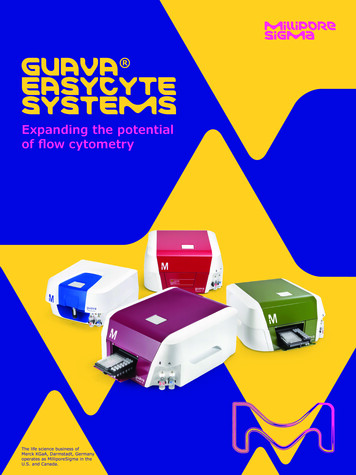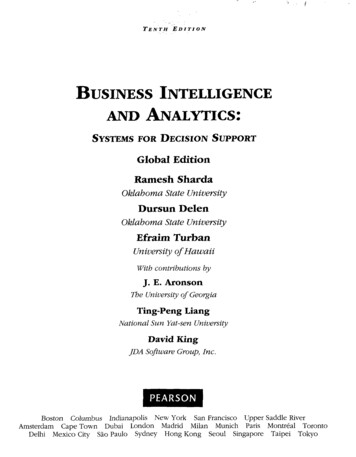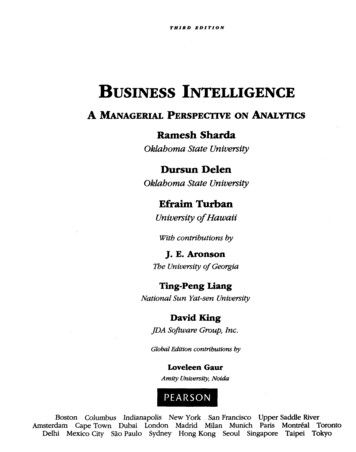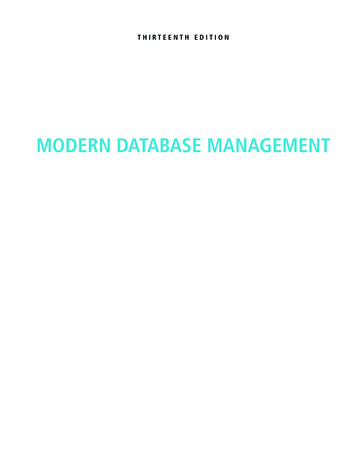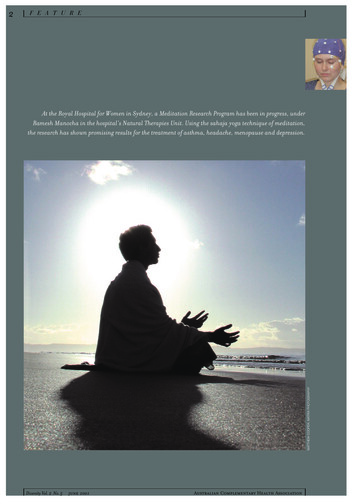
Transcription
F E A T U R EAt the Royal Hospital for Women in Sydney, a Meditation Research Program has been in progress, underRamesh Manocha in the hospital’s Natural Therapies Unit. Using the sahaja yoga technique of meditation,the research has shown promising results for the treatment of asthma, headache, menopause and depression.MATTHEW COOPER, MATRIX PHOTOGRAPHY2Diversity Vol. 2 No.5june 2001Australian Complementary Health Association
F E A T U R EResearchingmeditationClinical applications in healthcareDiversitypublished innatural & complementary healthmagazineVol. 2, No. 5 June 2001Dr Ramesh Manocha graduated inmedicine from the University of NewSouth Wales. After a number of yearsin clinical practice he becameinterested in the clinical applicationsof meditation. He is now Barry WrenFellow at the Royal Hospital forWomen, Sydney, where he initiatedthe Meditation Research Program.byramesh manochaThe ancient tradition of yoga and meditationbegan in Indian prehistory as a system of mental,physical and spiritual exercises. In approximately500BC the physician and sage Patanjali formalised thistradition into a science with four major and four lesserbranches involving ethical restraint, self-discipline,mental focus, physical exercise and meditation. Theentire system was used in an integrated fashion anddirected at the attainment of a unique state ofspontaneous, psychological integration.1 Modernpsychologists have described this state as“individuation”2 or “self-actualization”3 and it has beentraditionally termed “self-realisation”.Many studies of meditation and yoga have beenconducted over the past 50 years with variable results.4The advent of Transcendental Meditation in the 1960sand 1970s gave scientists an opportunity to study astandardised technique. Many interesting results wereobtained in multifaceted studies; however problemswith methodology and interpretation of data have beennoted.5 Similarly, other techniques have been assessedgiving results which are often remarkable but,unfortunately, inconsistent and difficult to reproduce.The cultic connotations of many of these techniques andthe organisations that promote them are also ofconsiderable and justifiable concern and have, nodoubt, hampered research in this area.6Yet the health practitioner continues to intuitivelyrecognise the role of stress in clinical illness,particularly in relation to the so-called“psychosomatic” diseases.7Despite the tremendous advances in modernmedicine we are still to develop truly effective strategiesto deal with the common public health problems thatcause most of the mortality and morbidity in the widercommunity. The use of stress reduction has been shownto be beneficial in many diseases, as it improvespsychological and physical health and lifestyleawareness.8 Importantly the utilisation of stressreducing techniques brings us closer to the ideal of aholistic, integrated health care strategy.Several mechanisms have been proposed toAn earlier version of this article was presented as a paper at the SixthInternational Holistic Health Conference at Lorne, Victoria, in March 1999.Australian Complementary Health AssociationDiversity Vol. 2 No.5june 20013
4R E S E A R C H I N GM E D I T A T I O Nexplain the way in which psychological stress translatesinto physical disease. Some of the mystery has beenexplained by the “general adaptation syndrome” in whichstressors induce psycho-hormonal changes. In an acutecontext these changes result in emergency adaptation ofphysiological function. In a context of chronicstimulation these changes, rather than maintainingpsychological homeostasis, ultimately result in physicaldebilitation of body systems.9 The “parasympatheticresponse”, or “relaxation response”, is anothermechanism worthy of investigation.10 It is thephysiological opposite to that of the “fight or flight”reaction that we are all familiar with. It involves a slowingof the heart rate, reduced rate of respiration andrelaxation of the muscles, in association with a reductionin circulating stress hormones and alpha brain waveactivity. This physiological reaction is mediated by theautonomic nervous system, a complex set of nerves thatSome years later, we, a handful of health workersin Sydney, came across Rai’s work. The results that hehad achieved in conditions ranging from asthma tohigh blood pressure were very encouraging so wedecided to test this technique under scientificconditions here in Australia. This was the beginning ofthe Meditation Research Program.Our first goal was achieved when we established theMind-Body Meditation Clinic. This was a non-profitservice that offered instruction in meditation to patientslooking for a more holistic approach to the treatment oftheir condition. A wide variety of patients were sent to uswith many different problems; most of them chronicconditions for which there was little to offer within themainstream of medicine. Within a few sessions ofinstruction most patients reported improvements. Someof the toughest cases, to our amazement, remittedcompletely with diligent practice of the technique.Brainwaves from a meditator as displayed on a computer screen.governs all the automatic systems of the body that areessential for life. The role of the hypothalamic pituitaryaxis, which is the main controlling centre for thehormonal activities of the body, is also worth considering.Regardless of the underlying theories, themajority of clinicians recognise that stress is a majorcontributor to disease and that a simple stressmanagement technique, such as meditation - oncescientifically proven and clinically evaluated - couldbe widely applied in the clinical setting.SAHAJA YOGAAbout fifteen years ago in India, Professor U.C. Raiaccomplished some pioneering work with a technique ofmeditation called sahaja yoga. He was head of theDepartment of Physiology at Maulana Azad MedicalCollege in Delhi. He himself had suffered serious anginaattacks and was surprised to find that this technique ofmeditation seemed to alleviate his medical condition.Professor Rai, impressed by this personalexperience, sought to scientifically document the effectsof this technique. He set up a multifaceted researchproject. Part of this was a study on the effects of sahajayoga meditation on chronic illnesses such as epilepsy andasthma. Rai’s research team found that regular practice ofthis technique reduced the frequency, severity andduration of his patients’ epileptic seizures.11 Moreover,when Rai taught another group a mimicking exercise,which resembled but was actually not the real technique,the same improvement did not occur!12Diversity Vol. 2 No.5june 2001ANDREW: TAMING THE BRAINSTORMSo when “Andrew” arrived in our clinic one day, wewere not unaccustomed to challenges. Andrew was ayoung man of about twenty years of age when his motherbrought him to the meditation clinic at Blacktown, aworking class suburb in Sydney’s outer west.Two years before this, he had contractedencephalitis, a viral infection of his brain tissue whichput him in hospital for several weeks; his condition socritical at one stage that he was transferred into theintensive care unit. Although Andrew did survive, theviral attack on his brain had left subtle scars on thismost sensitive of organs. It caused the neurons to“short circuit” and produce overpowering waves ofelectrical signals that spread across his entire brain.This “brainstorm” resulted in severe epilepticseizures. While the viral infection of Andrew’s brainwas over, it had left behind permanent damage whichcondemned him to a life of violent epilepsy.Epilepsy is a well recognised complication ofbrain infection. In this case it had taken a promisingand talented student and turned him into an invalid.Andrew’s fits were so frequent - sometimes up to twoor three times per day - that he could neither resumehis schooling nor keep a job. He was dependent on hisparents for everything, and so their lives had alsobecome considerably restricted by their son’s illness.As with the other patients in the Mind-BodyMeditation Clinic, we advised Andrew that hisresponse to the technique would mostly beAustralian Complementary Health Association
R E S E A R C H I N G5M E D I T A T I O NMATTHEW COOPER, MATRIX PHOTOGRAPHYParticipant in the Meditation Research Program, with a QEEG headcap designed to pick up electrical signals produced by the brain, and thusmonitor changes in brainwave activity during meditation.A study of sahaja yoga meditators usinga Quantitative Electro Encephalo Gram,demonstrated widespread changes inbrainwaves, with prominent theta waveactivity at the precise moment that themeditators reported a state of completemental silence and “oneness”.determined by his own motivation to meditateregularly. We were not the healers in the clinic, ratherAndrew was going to learn how to awaken an innateand spontaneous healing power within himself. Thisenergy would work inexorably through his meditationto improve his physical, mental and spiritual health.Professor Rai’s epilepsy research showed thatpatients who practised the technique consistentlyexperienced reductions in the amount and severity of thefits that they were experiencing. This gave us confidencethat Andrew could use this technique to his benefit.Andrew learned the sahaja yoga technique quicklyand practiced it diligently. The first changes we noticedwere in Andrew‘s face: his eyes lost their usual dullness;they looked clear and bright. When we first saw this 19year old boy he looked like an old man: hunched over,drawn face and dark rings under his eyes. Now he startedto look young again and the dark shadow that seemed tohang over him had gone. After a few weeks he would evencome to the class with a smile where usually there wasonly a frown. Andrew’s progress was obvious to us and itwas not too much of a surprise to hear from his parentsthat his fits were reducing in frequency.After several weeks his mother came to the clinic toinvite us home for dinner. Andrew had not had a major fitin four weeks, they were planning to go away for theweekend and for the first time in many years life wasstarting to look normal for them!ASTHMA RESEARCHSuccessful cases like Andrew’s and many of the otherpatients were inspiring for us all, but single casehistories, no matter how remarkable, do not constitutescientific proof. The medical science establishmentdemands a standard of scientific rigour in order toestablish the authenticity of any new form of treatment.So after more than two years of the meditation clinic wehad enough confidence and had gathered sufficientevidence to embark on a proper attempt to scientificallyevaluate the sahaja yoga technique.Australian Complementary Health AssociationIt so happened that Professor Rai had also lookedat the effect of meditation on asthma during hisinvestigation into the sahaja yoga effect. So we decidedto use his results along with our accumulatedexperience at the meditation clinic as a basis for anasthma trial here in Australia.In consultation with a number of respected asthmaresearchers a strategy was devised to compare the effectof meditation against a simple relaxation technique. Wewanted to know whether there really was somethingunique about this process or if it was simply like anyother relaxation technique. Our plan involved selectinga large group of people with severe asthma whosecondition did not properly respond even to maximumlevels of medication. These people were divided intotwo groups. One group received regular instruction insahaja yoga meditation while the other group was taughta popular relaxation technique. Before, and then after,about 16 sessions, the patients were assessed and thetwo groups compared to see if there was a differencebetween the two techniques. The Royal AustralianCollege of General Practitioners funded the project andafter 18 months it was completed.The results were surprising! Most of us expectedto see no difference at all between the relaxation andmeditation groups. Yet the results clearly showed thatwhile both groups did appear to bring aboutimprovements in the way the patients felt, themeditation also showed improvements in the severityof the disease process itself! This effect was not seen atall in the relaxation group and it suggested thatmeditation can actually influence the disease process.DAVID: A BREATH OF FRESH AIRThere were many remarkable individual storieswithin the Asthma project. One of them is “David’s”. Atypical 42 year old “Aussie battler”, he had sufferedasthma since infancy, which had greatly frustratedboth his career and his sporting ambitions. When weassessed him prior to his entry to the trial his asthmaDiversity Vol. 2 No.5june 2001
6R E S E A R C H I N GM E D I T A T I O NSequence showing a group of meditators sitting with the founder of the sahaja yoga meditation technique, Shri Mataji Nirmala Devi. The photographs appear torecord rays of light eminating from the meditators, not visible to the naked eye. This may represent an increased radiation of subtle energy during meditation.was in the severest of categories. Simply blowing intothe spirometer, a machine used to test lung capacity,caused his asthma to worsen! After sixteen weeks ofmeditation, which he took to like fish to water, hereturned for reassessment.At the lung function laboratory we saw a changedman. David’s lung function had increased, his symptomsreduced massively and the standard tests that initiallyplaced him in the severest of asthma categories nowindicated that his asthma was one of the mildest! Davidtold us that his asthma had improved so much that he wassleeping through the night rather than being woken withsymptoms; that he was playing sport; and that he hadsaved more than 1,500 in medication expenses since hestarted the program!HOT FLUSHESHot flushes are a common problem amongstwomen in their menopausal years. In fact 90% ofwomen can expect to experience menopausalsymptoms of which the hot flush is the most common.It is an experience characterised by flushing ofthe skin of the upper part of the body, sweating,a sensation of heat and associated feelingsof unwellness.“What a great thing it would be if we inour busy lives could restore into ourselveseach day for at least a couple of hours andprepare our minds to listen to the voice ofthe great silence. The divine radio is alwayssinging if we could only make ourselves readyto listen to it, but it is impossible to listenwithout silence.”Mahatma GandhiInterestingly, the hot flush can be worsened orbrought on by stress. In fact many women report thathigh-pressure situations greatly worsen the numberand severity of the flushes that they experience. Also,women report that their flushes improve somewhatwhen they are calm and relaxed.With this in mind we set up a pilot trial of hot flushesfor menopausal women. Ten women were enrolled intoan eight-week program. The frequency and severity oftheir hot flushes and other menopausal symptoms wererecorded using standard methods before and after the 8week program. The results were very impressive with allwomen experiencing improvement in their condition. Infact 9 out of the 10 women reported at least 50%reductions in the frequency of their hot flushes. Six ofthese women had a 65-70% improvement in their hotflushes which, after eight weeks of meditation“treatment”, is comparable to that seen in conventionalDiversity Vol. 2 No.5june 2001Australian Complementary Health Association
7M E D I T A T I O NGEOFFREY GODFREYR E S E A R C H I N Ghormone replacement therapy! In addition, standardmeasures of quality of life and symptom profiles showedsimilar degrees of improvement.We are now planning a larger, randomised,controlled trial to more conclusively determine thepotential for meditation in this troublesome problem.HOW DOES IT WORK?How does meditation bring about these effects? The“sahaja yoga hypothesis” is that meditation triggers aprocess within the autonomic nervous system, a complexset of nerves that governs the function of all the organs ofour body. Imbalance within this system, says thehypothesis, is the cause of both physical andpsychological illness. The process of meditationrebalances this system thereby allowing our naturalhealing processes to revitalise and rejuvenatediseased organs.The ancient yoga tradition explains the inner healingprocess in terms of seven subtle energy centres (called“chakras”) that exist within our body. Each of thesecentres governs a specific set of organs, and aspects of ourpsychology and spirituality. Imbalanced function of thesecentres results in abnormal function of any aspect of ourbeing (physical, mental or spiritual) that relates to theimbalanced centre.Meditation is said to be a specific process thatinvolves the awakening of an innate, nurturing energycalled “kundalini”. The awakening of the kundalinicauses it to rise from its position in the sacrum bone andpierce through each of the chakras, causing each of themto come into a state of balance and alignment (like astring threading through a series of beads). In this waythe chakras are rejuvenated and nourished by thekundalini’s ascent. As the kundalini reaches the brainand the chakras within it, mental tensions areneutralised. An inner state of mental calm is established.This inner silence becomes a source of inner peace thatneutralises the stresses of daily life, enhancing creativity,productivity and self-satisfaction.advanced sahaja yoga meditators using a QEEG(quantitative electro encephelo gram) has yielded somevery interesting results. This method is able to producetwo-dimensional maps of the electrical changes in thebrain as the meditator enters into the state ofmeditation. Our study was conducted on a small groupof meditators who were each asked to meditate whilewearing a QEEG headcap designed to pick up the tinyelectrical signals produced by the brain.They were instructed to sit quietly for some time,then to commence meditation and signal when theyhad definitely entered into the meditative state called“thoughtless awareness”. The findings werefascinating: all three of the meditators displayedwidespread changes in brainwave activity that becamemore intense as they meditated.BRAIN WAVESIn order to try and understand what it is aboutmeditation that makes it special we have turned to somesophisticated brain imaging technology. A pilot study ofAustralian Complementary Health AssociationDiversity Vol. 2 No.5june 2001
8R E S E A R C H I N GM E D I T A T I O NSanskrit for “effortless”).Third, the focus of theta activity at the front of thehead and top of the head, both in the midline, suggest thatstructures deep within the brain, possibly the limbicsystem, are being activated. The limbic system isresponsible for many aspects of our subjectiveexperiences, such as emotion and mood, so it is nosurprise that meditation, which is traditionally associatedwith blissful states, might involve this part of the brain.Finally, in speculation, the two areas of thetaactivity coincidentally correspond to the two mainchakras in the brain, according to yogic tradition. Theforehead chakra called “agnya” or “third eye” is locatedin the centre of the forehead while the chakra at the topof the head, is called “sahasrara” or “crown chakra” andis traditionally associated with the limbic system.VIBRATIONAL ENERGYMany practitioners in the complementary healthfield subscribe to the idea of “vibrational medicine”. Thisidea essentially suggests that complementary therapiessuch as homoeopathy and therapeutic touch, as well asother therapeutic phenomena such as the placebo effect,therapeutic contact, bedside manner, and spiritualhealing, act on a subtle energetic level to achieve cure orJAPAN NATIONAL TOURIST ORGANIZATIONANGELO BUTAVAWidespread, intense “alpha wave” activity occurredinitially. Alpha wave activity is associated with relaxationand is thought to be a beneficial state. In fact alphaactivity has been observed in a number of different formsof meditation. The remarkable thing, however, is that asthe meditators signalled that they had entered into thestate of mental silence, or “thoughtless awareness”,another form of brain wave activity emerged whichinvolved “theta waves” focused specifically in the frontand top of the brain in the midline.Precisely at the time that the theta activity becameprominent, the meditators reported that theyexperienced a state of complete mental silence and“oneness” with the present moment, a state whichcharacterises the sahaja yoga meditative experience.There are several remarkable features about thispilot study which warrant further investigation.First, very few meditation techniques have shownthis kind of consistent change in the theta rangesuggesting that the technique may have a unique effecton the brain. We were only able to find one otherstudy, out of several dozen published in the scientificliterature, that showed changes of this nature. Thisstudy involved a group of Japanese Zen monks.Practitioners of sahaja yoga often claim to feel thechakras (energy centres) within the head open up as theMeditation at a Zen Buddhist temple in Japan (above) and at the Buoyancy Foundation in Melbourne (right). Zen meditation andsahaja yoga meditation are the only two types of meditation which have demonstrated prominent theta brainwave activity.meditative experience intensifies. They assert that it isthis experience which is the essence of true meditationand that very few other meditation techniques enablethe subject to repeatedly access this experience. Thefact that the theta activity is relatively unusual and that itwas observed in coincidence with the meditators’reported experience does suggest that there may besomething unique and authentic about the sahaja yogamethod and its claims.Second, it is very significant that the changesobserved in the brain images occurred at the momentthat the meditators reported experiencing themeditative state. This suggests that the QEEG methodmay make it possible to directly study mystical statesof consciousness! The fact that these changes occurredwithin minutes rather than hours or longer suggests arelatively effortless or spontaneous process (assuggested by the name of the technique - “sahaja” isDiversity Vol. 2 No.5june 2001promote wellness. The difficulty has been that we areunable to detect this “subtle energy” and so scientificverification of this concept is difficult to achieve.However Kirlian photography, new research technologysuch as SQUID (“superconducting quantum interferencedevice”), and aura imaging all offer clues to the puzzle.The yogic explanation is simple: all therapeuticmodalities act in one way or another on the subtle systemof chakras and kundalini. This idea is difficult to directlyverify but while doing background work and interviewsfor our research program a number of sahaja yogapractitioners described unusual sets of photographs thathad been taken of sahaja yoga meditators. There appearedto be a wide variety of these photographs displaying, forthe most part, rays and streaks of light around people.One series of photographs, which included a group ofmeditators sitting with the founder of the sahaja yogameditation technique, Shri Mataji Nirmala Devi, wasAustralian Complementary Health Association
R E S E A R C H I N Gparticularly interesting. It consisted of a series ofphotographs in which the “vibrational energy” emitted bythe individuals was recorded in the photographs,progressively becoming more intense with eachphotograph. Remarkably, these photographs wereallegedly taken well before the age of digital photography.Of even greater interest was that the people who ownedthis fascinating evidence were not particularly fussed asto whether or not it should be publicised. When Iexpressed my surprise at their apparent diffidence, theyreplied that photographic evidence was irrelevant tothem as the primary goal of their technique was personalmeditative experience rather than the collection ofphysical artefacts - no matter how remarkable.THE EASTERN VIEW OF STRESSMeditation is an eastern tool that offers westernhealth practitioners a new way of looking at health. Therole of stress in disease is well recognised by modernmedical researchers but, despite the progress that hasbeen made in this field, there remains some veryfundamental yet unanswered questions. One of thosequestion is, “What exactly is stress?”. Few of us can easilycome up with a good definition of “stress”, yet while wedon’t know exactly what it is, we intuitively recognise thatM E D I T A T I O Nwhile we can think about events in the past (even a fewmoments ago), or events scheduled in the future (evenmilliseconds in the future), it is impossible to actuallythink about the present moment which we arecontinuously experiencing and is ever changing.Now think about the stress that we all experiencefrom time to time. Despite the huge variety of situationsthat “stress” us they all have one thing in common: wehave to think about the events before they can reduce oursense of wellbeing. In other words thought itself is thefinal common pathway by which all events create stresswithin us!The past, comprised of events that have alreadyoccurred, no longer exists. Similarly the future,comprised of events that have yet to occur and aretherefore undetermined, does not yet exist. However,paradoxically, we human beings exist only in the present.The mind (and its thoughts), since it is comprised only ofstuff from the past or future, is therefore not real and sothe stress that it generates is also not real!If we are beings that exist in the present, and werealise that the stress and angst of life emanate from amind which is the product of past/future, weacknowledge also that the antidote for the mentalillusions that cause stress is to reign in our attentionand focus it on the present moment.In a trial of sahaja meditation, 9 out of 10menopausal women reported at least 50%reduction in frequency of their hot flushes,and the overall improvement in theircondition was comparable to that seen inhormone replacement therapyit is a factor that affects almost every aspect of our lives!The eastern explanation of “stress” is probably oneof the most commonsense and practically useful ones.While you read this see if you can “look inside” and applythis perspective to yourself. Stress, says the easternperspective, is the by-product of thought. If we examinethe nature of the thoughts that each of us experiencesfrom moment to moment we will find that they all relateto one of two broad categories: (l) events that haveoccurred in the past or (2) events that we anticipate willoccur in the future. Whether the event was an argumentwith a friend yesterday (past), an unpaid bill (future), adeeply troubling childhood experience that has becomepart of our subconscious (past) or anxiety about the sharemarket (future) we will find that all of these troublingthoughts, and the resulting stress that they cause us, tohave arisen from only the past or future!Take the exercise a little further. If the vastmajority, if not all, our thoughts emanate from eventsin the past or future, is it possible to think about theabsolute present moment? Most of us will admit that,Australian Complementary Health AssociationDiversity Vol. 2 No.5june 20019
10R E S E A R C H I N GM E D I T A T I O NWhile, for most of us, focusing on the absolutepresent moment is virtually impossible, it is this razor’sedge of “thoughtless awareness” that the easternerseeks to cultivate and sustain in meditation. The vastinner silence of the thoughtless state leaves the minduncluttered. By existing in that “space-between-thethoughts” one is neither enslaved to one’s past norconfined to a predetermined future. The inner silenceof meditation thus creates a naturally stress-freeinner environment.LIVING IN THE MOMENTIs it possible for humans to live in the presentmoment? Yes, it is, and most of us encounter livingexamples of it regularly!Observe closely the next small child you encounter.They have no worried lines on their faces, are almostalways playing and enjoying themselves, and rarelycomplain about bills, jobs, chores, etc. If one happens tohave an unpleasant experience it is quickly forgotten andlife goes on. They are naturally balanced, living-in-thepresent, stress-free beings. Who has seen a toddler holda grudge, worry about the next meal or even think aboutwhat they did yesterday or will do tomorrow? They are sofocused on the present moment that they are entirelyspontaneous, unpretentious and usually very happy. Theyare in a constant state of effortless meditation.Living in the moment is not, however, aregression to immaturity. It is an evolutionary step inwhich we return to our childlike innocence andsimplicity but in full awareness of ourselves, our placein society and our moral role and responsibility.How does one tap into and sustain a connectionwith the present moment? How does one escape thebrainstorm of mental stress that we all experience?We would all agree that more research needs to beDiversity Vol. 2 No.5june 2001done to try to understand how the “sahaja yoga effect“occurs. Does it work via the autonomic nervous system?Is it really the result of an energy that exists within each ofus called kundalini? Is it possible to examine the mostancient of traditions with modern science? TheMeditation Research Program at the Royal Hospital forWomen will continue to delve into these importantquestions.13 Suffice to say for now that sahaja yogameditation appears to offer a method by which each of uscan tame the brainstorm, realise a state of peace andtranquillity and begin to heal our body, mind and spirit.Meditation Research Programme, The Natural TherapiesUnit, Royal Hospital for Women, Ph (02) 9382 6626, Fax (02)9382 6660. Email: r.manocha@unsw.edu.auReferences1. Neki, J.S., “Sahaja: an Indian ideal of mental health”, Psychiatry,Vol. 38, No. 1, Feb 1975, pp. 1-10.2. Van der Post, L, Jung and the Sto
The advent of Transcendental Meditation in the 1960s and 1970s gave scientists an opportunity to study a standardised technique. Many interesting results were . management technique, such as meditation - once scientifically proven and clinically eva



